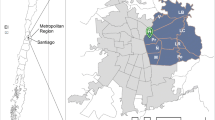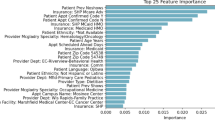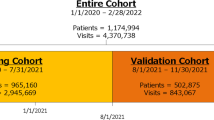Abstract
The term “no-show” refers to scheduled appointments that a patient misses, or for which she arrives too late to utilize medical resources. Accurately predicting no-shows creates opportunities to intervene, ensuring that patients receive needed medical resources. A machine-learning (ML) model can accurately identify individuals at high no-show risk, to facilitate strategic and targeted interventions. We used 4,546,104 non-same-day scheduled appointments in our medical system from 1/1/2017 through 1/1/2020 for training data, including 631,386 no-shows. We applied eight ML techniques, which yielded cross-validation AUCs of 0.77–0.93. We then prospectively tested the best performing model, Gradient Boosted Regression Trees, over a 6-week period at a single outpatient location. We observed 123 no-shows. The model accurately identified likely no-show patients retrospectively (AUC 0.93) and prospectively (AUC 0.73, p < 0.0005). Individuals in the highest-risk category were three times more likely to no-show than the average of all other patients. No-show prediction modeling based on machine learning has the potential to identify patients for targeted interventions to improve their access to medical resources, reduce waste in the medical system and improve overall operational efficiency. Caution is advised, due to the potential for bias to decrease the quality of service for patients based on race, zip code, and gender.
Similar content being viewed by others
References
Carreras-García D, Delgado-Gómez D, Llorente-Fernández F, Arribas-Gil A. Patient No-Show Prediction: A Systematic Literature Review. Entropy. 2020;22(6):675. https://doi.org/10.3390/e22060675
Kurasawa H, Hayashi K, Fujino A, et al. Machine-Learning-Based Prediction of a Missed Scheduled Clinical Appointment by Patients With Diabetes. J Diabetes Sci Technol. 2015;10(3):730-736. https://doi.org/10.1177/1932296815614866
Kim DW, Jang HY, Kim KW, Shin Y, Park SH. Design Characteristics of Studies Reporting the Performance of Artificial Intelligence Algorithms for Diagnostic Analysis of Medical Images: Results from Recently Published Papers. Korean J Radiol. 2019;20(3):405-410. https://doi.org/10.3348/kjr.2019.0025
Lundberg S, Lee SI. A unified approach to interpreting model predictions. arXiv. 2017. https://doi.org/10.48550/arXiv.1705.07874
Allen B, Dreyer K. The Role of the ACR Data Science Institute in Advancing Health Equity in Radiology. J Am Coll Radiol JACR. 2019;16(4 Pt B):644-648. https://doi.org/10.1016/j.jacr.2018.12.038
Author information
Authors and Affiliations
Corresponding author
Ethics declarations
Competing Interests
The authors declare no relevant conflicts of interest.
Additional information
Publisher's Note
Springer Nature remains neutral with regard to jurisdictional claims in published maps and institutional affiliations.
Rights and permissions
About this article
Cite this article
Rothenberg, S., Bame, B. & Herskovitz, E. Prospective Evaluation of a Machine-Learning Prediction Model for Missed Radiology Appointments. J Digit Imaging 35, 1690–1693 (2022). https://doi.org/10.1007/s10278-022-00670-3
Received:
Revised:
Accepted:
Published:
Issue Date:
DOI: https://doi.org/10.1007/s10278-022-00670-3




